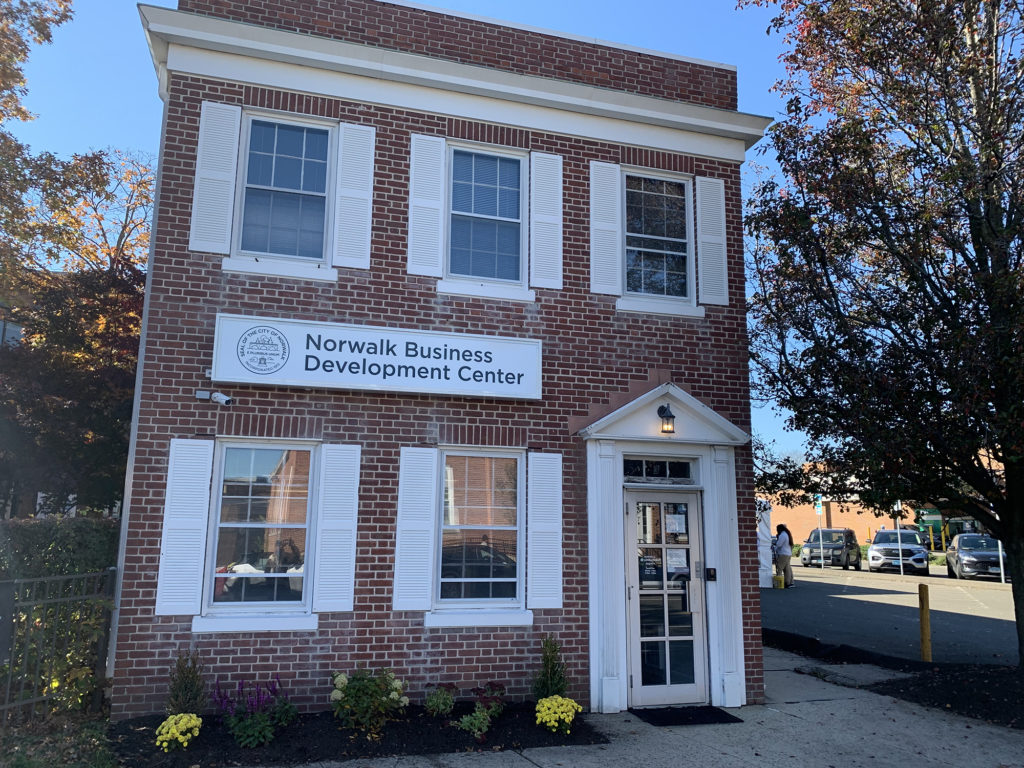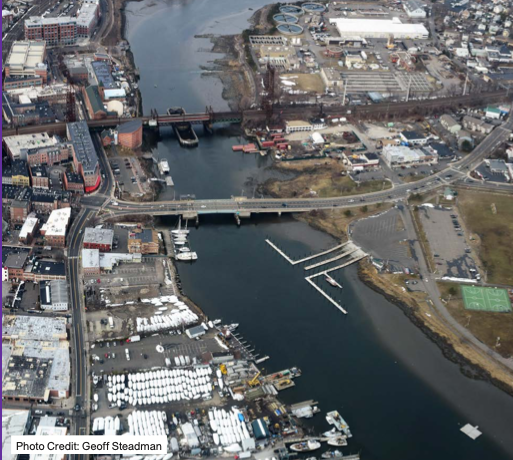Norwalk's New Business Development Center
Norwalk is recognized by families and businesses as one of the best places to live. Its population now exceeds 92,000 residents and it is the 6th largest city in Connecticut. It comes as no surprise that there is a lot of economic opportunity in Norwalk, and new businesses are starting up on a very regular basis. To aid Norwalk-based entrepreneurs and new business owners, the city has created a new Business Development Center. Read on to learn about this brand new facility and the services provided.
What is the Business Development Center?
[caption id="attachment_2140" align="alignleft" width="1024"]

Photo courtesy of Nancy Chapman[/caption]
The new business center, located at 3 Belden Avenue, was opened on November 3, 2022. It’s designed to be an all-inclusive resource that entrepreneurs and business owners can utilize throughout the life cycle of their businesses. This center was constructed using various sources of federal, state, and local funding. The American Rescue Plan Act gave the development center a vital infusion of funding to help complete it.
"We have the opportunity to have staff onsite to be able to assist with local and state grants, be able to build business plans, business models, offer professional development training, and be able to offer residents…and people in the region, as a whole, an opportunity to be able to take a dream that they may have stored for a very long time and actually make it a reality,” says Jessica Vonashek, Chief of Economic and Community Development for the City of Norwalk.
What Services does the Business Development Center Provide?
 Whether you are looking at starting a business or expanding one, the development center can help you. Services are extensive and cover a variety of topics:
Whether you are looking at starting a business or expanding one, the development center can help you. Services are extensive and cover a variety of topics:
- Financial Education
- Loan or Grant Application Assistance
- Technical Support for Local, State, or Federal Permitting
- Business Plan Development and Implementation
- Local and State Licensing Requirements
- Insurance for Your Business
- Market Research
Financing is another popular topic among entrepreneurs. Prospective business owners want to know how to infuse capital into their companies. The Business Development Center resources can walk you through traditional lending options, local programs, and Small Business Administration (SBA) programs.
All of these resources are available free of charge to ensure these resources are accessible to everyone.
The Business Development Center is a partnership with the City of Norwalk, the Greater Norwalk Hispanic Chamber of Commerce, The Greater Norwalk Chamber of Commerce, SCORE, the Small Business Development Council, the Norwalk Redevelopment Agency, the Women’s Business Development Council, and the NAACP. This partnership ensures that there is support for your business that is diverse and equitable.
Have More Questions?
With the help of private sector experts and higher-education resources, you can make your dream of starting your new business in Norwalk, CT a reality. If you want to learn more about Norwalk’s Business Development Center, contact us today or come visit us at the Norwalk Business Development Center Monday through Friday from 9 am to 4 pm. Norwalk, CT Holds Charrette on Revising Its Building Zone Regulations
 This fall, the City of Norwalk held a charrette focused on rewriting and modernizing its building zone regulations which lasted over the course of five days. A charrette is a collaborative planning process that involves all stakeholders and this one was open virtually to the public.
This fall, the City of Norwalk held a charrette focused on rewriting and modernizing its building zone regulations which lasted over the course of five days. A charrette is a collaborative planning process that involves all stakeholders and this one was open virtually to the public.
Norwalk embarked on a building zone regulation update following its ten-year Citywide Plan in 2019. One of the Plan’s recommendations was to take a fresh look at the city’s zoning regulations, which have not been thoroughly reviewed nor revised in 30 years. The charrette was part of a greater public outreach process to educate local citizens on the zoning code and get their input and feedback on what works and what needs to be changed.
How the Virtual Charrette Worked
During the charrette, the community learned about the city’s current zoning regulations. In a series of online focus meetings, stakeholders shared their hopes and concerns about how the new regulations may affect things such as transportation, architecture and design, community character, land use, development, neighborhoods, housing, green infrastructure, sustainability, and most desirably its waterfront charm.
For those who couldn’t make it to one of the meetings, an online virtual open studio was available for much of the day where people could join and ask questions, or share their thoughts on zoning.
Another way the city was able to get input from the public during the charrette was through a virtual mapping workshop. Using an online tool, people were able to access a map of the city and add markers to indicate what they liked about the character of Norwalk and their thoughts on opportunities for improvement.
Findings from the Charrette
As mentioned in a report from The Norwalk Hour, “if one word was said more often than any other word this week, it was character. We heard from people wanting to maintain the marine character. Views of the water are important.”
On the final evening of the virtual charrette, the planning team presented their findings and discussed how the community input is shaping the new Building Zone Regulations in several areas. Here are some of their findings.
Housing
During the charrette, people asked for a greater variety of housing types in more locations. Allowing for multifamily and accessory dwelling units that fit into the character of single family neighborhoods. Part of this is an expressed need and desire for more affordable workforce housing.
Sustainability and the Environment
Important to charrette attendees is the maintenance of the maritime character of the city, and the need to preserve water views. The protection of natural resources and the coastline is also a public concern.
Attendees talked frequently about the need for green infrastructure such as permeable pavement, accessibility for bicycling and pedestrians, solar power, green roofs, and sustainable stormwater solutions.
Industry and the Economy
While open, green space and preserving the character of neighborhoods were important to charrette attendees, there was discussion about protecting some industrial zones. There was a call to look at other locations for these zones than where they are currently.
The biggest concern with industrial zones was the need to address the contractor yards in these neighborhoods and adjacent to homes. There is a Norwalk Industrial Zones Study underway which is taking a look at these issues.
Also of importance for attendees was protecting water dependent commercial uses while still allowing for public access to the water. Currently, the city is working on an Industrial Waterfront Land Use Plan to guide decisions on the best uses of Norwalk’s waterfront resources.
Overall, the public wanted to retain, grow, and attract a wide range of businesses, allowing for various commercial building types that are more compatible in more areas.
Mobility and Transportation
Managing all modes of transportation was a critical concern for attendees, especially making land use decisions that support and improve walking, biking, and public transit.
Parking was brought up as having an impact on the character, walkability and desirability of the community. There were presentations on shifting parking lots to be hidden and interspersed among businesses as attendees expressed an interest in a review of parking standards.
Next Steps in the Zoning Regulations Update
The zoning regulations planning team is taking all the feedback from the charrette and drafting new regulations. The intention is to simplify what is now a complicated document, and consolidate some of the zoning districts.
The overall policy will be to take a character-based approach to zoning. This means grouping zones together that are similar, and creating character districts where certain building types are appropriate for each district, while taking into consideration policies such as open space and commercial uses, etc.
Residents, businesses and others in the community will have the opportunity to review and provide feedback to the draft, continuing the important public input to ensure the new regulations take into account all who live and work in Norwalk.
To see videos from the Charrette Presentations CLICK HERE Recommendations for Norwalk’s Industrial Zones: A Guide
 Norwalk recently underwent a study of its industrial zones to take a look at the different types of industrial development in various areas of the city, and how industrial and commercial zoning can best be used for economic and job growth.
How can the city become more modernized? How should the city change the industrial zone definition? What should industrial zones look like in Norden Place and along the waterfront?
These are just a few questions examined in the study.
The Norwalk Industrial Zone Study included conversations with city staff, industrial business owners, residents, and other local stakeholders. Below is a quick overview of the study’s recommendations.
Norwalk recently underwent a study of its industrial zones to take a look at the different types of industrial development in various areas of the city, and how industrial and commercial zoning can best be used for economic and job growth.
How can the city become more modernized? How should the city change the industrial zone definition? What should industrial zones look like in Norden Place and along the waterfront?
These are just a few questions examined in the study.
The Norwalk Industrial Zone Study included conversations with city staff, industrial business owners, residents, and other local stakeholders. Below is a quick overview of the study’s recommendations.
Simplify Zoning Classifications for Modern Uses
Industry in Norwalk has evolved over the years. Commercial zones previously developed for agriculture and manufacturing need modernization. Yet, the city still needs to make room to attract construction projects and other heavy industrial works.
One recommendation of the Industrial Zone Study is to simplify zone classifications to make them more in line with contemporary uses. This would distinguish each zone class by the type of industrial uses allowed, the types of contractors permitted, and whether or not residential uses in the zones are permitted.
There are four proposed industrial categories for the zoning districts:
- Heavy Industrial - this include intensive manufacturing, contractor yards, utilities and waste management
- Mixed-use Heavy Industrial/Commercial - this includes heavy industry but also allows commercial upper floor uses such as offices, research and development, showrooms, and other industrial services.
- Mixed-use Light Industrial/Commercial - this would include light manufacturing uses, as well as research and development, limited warehousing, and other less intensive industrial services.
- Mixed-use Artisan - these zones would allow boutique manufacturing, textile companies, bakeries, beverage and spirits production, and artist studios.
Special Development Plan for Norden Place
Norden Place is a unique area because of its industrial history and location. The site takes up more than three dozen acres in Norwalk and is an ideal location for an industrial zone. However, there are specific challenges that need to be addressed when planning for its future use. For one, it is adjacent to I-95, yet drivers must go through residential areas to access the highway.
The study recommends preparing a development plan just for the Norden site. While a warehousing center for Norden Place may not be ideal, mixed commercial/industrial users should be able to make use of the location. Potential uses might include research and development, life science and biotech companies, or a data center. Importantly, they should discourage residential uses.
Along with the planning for Norden Place, the city should examine and devise a plan for access to I-95. It may be possible to open additional ramps to the highway, though it’s important to bear in mind the effects of these construction projects on city residents. One solution could be including buffering strategies to minimize noise pollution along the highway. They may also want to restrict vehicular traffic in the zone to passenger vehicles and small trucks only.
Differentiate Between Contractor Yards and Others
While contractor yards are permitted in industrial zones, contractors can include a large array of service providers from plumbers and electricians to site contractors and sand/gravel storage facilities. The sweeping term ignores the realities that each industry has its own needs and in zones with more intensive contractor yards and heavy industry conflicts can arise when they are intermingled with residential uses.
The study proposes that the city should distinguish between contractor yards with heavy truck traffic and impact on the site, and contractor offices that have only a few service vehicles and less effect on its surroundings. Distinctions should also be drawn between contractor operations with outdoor vs. indoor storage.
Some other requirements suggested for zoning regulations for contractor yards include:
- Locating them in accessible locations that will not cause traffic problem
- Adding buffers adjacent to these yards and access to major roadways
An additional recommendation of the Norwalk Zoning Study is limiting self-storage facilities, which are presently under a moratorium in the industrial zones. The reason for this is that self-storage takes up valuable industrial land, but is not the best use of the property. These facilities provide limited jobs and economic development potential, and don’t promote an active pedestrian environment on the ground floor such as retail or restaurants, which add to the vitality of the neighborhood.
Develop a Unique Waterfront Plan
Historically, Norwalk has had industrial zones along the Norwalk River, but this waterfront is a unique area with many uses, regulations, and other pressures. The plan suggests that the city should take into consideration the many other issues that affect the land use along the waterfront, including the environmental impact, water quality, coastal resiliency, public access, recreational uses, as well as economic development opportunities related to the water.
In fact, the city has already begun to develop an Industrial Waterfront Land Use Plan to determine the best use of its waterfront, taking into account the many diverse challenges.
How Norwalk Industrial Zones Can Improve
Norwalk industrial zones can become more effective for today’s economy. By differentiating between different kinds of industry and creating new classifications the city can accommodate a larger variety of businesses and more mixed-use buildings.
Norden Place and the waterfront are two industrially zoned areas that are unique and should be studied, planned, and developed separately.
By taking steps outlined in the Industrial Zone Study, Norwalk is planning for the future. A future that encourages economic development balanced with residents’ needs and the environment.
Norwalk Social Media App Gets Reboot
[repost from
The Hour]

A Norwalk company has lined up $25 million in backing, after more than 4.5 million people downloaded its app that shares ad revenue with social media “influencers” and artists who use it to post videos, photos and other content.
Display Social is a reboot of a social media startup called Tsu, which underwent a bankruptcy in 2016 only two years after its formation, even as celebrities like Rihanna, Justin Timberlake and William Shatner tried out the platform.
Applications Being Accepted for 2021 Neighborhood Assistance Act Program
 If you're a nonprofit in Norwalk, CT you may be
If you're a nonprofit in Norwalk, CT you may be interested in applying for the Connecticut NeighborhoodAssistance Act Program (NAA).
The Norwalk Redevelopment Agency is handling the application process for tax exempt organizations in Norwalk.
The deadline for applying is 5 p.m. on May 10, 2021.
What is the Neighborhood Assistance Act Program? Read on and we'll fill you in on the details on how it works and how both area businesses and the Norwalk community benefit from this program.
Connecticut Neighborhood Assistance Act Program
The Connecticut Neighborhood Assistance Act program is a tax credit program designed to incentivize businesses to provide funding to support approved municipal and tax-exempt organizations.
Businesses may be eligible for a tax credit of up to 60% of the amount they contribute to one of these organizations. Tax credits may even go as high as 100% of the contribution amounts for certain qualified programs.
How Do Nonprofits Qualify For The Program?
Community programs must be approved by both the municipality in which the programs are conducted and by Connecticut’s Department of Revenue Services. A tax exempt organization interested in participating in the NAA Program must first complete in its entirety the program proposal application, Form NAA-01. This form must be submitted for approval to the municipality where the tax exempt organization’s program is conducted. In Norwalk that is the Norwalk Redevelopment Agency. All approved applications will then be sent to the CT Department of Revenue for another round of reviews.
Organizations that qualify include, but are not limited to:
- Employment and training
- Energy conservation
- Child care services
- Substance abuse
- Neighborhood assistance
What Are The Guidelines For Businesses?
Although the program is available to a wide range of businesses, there are some parameters to be followed to qualify. For one, the annual tax credit is limited to $150,000. There is also a minimum contribution amount of at least $250 to qualify for the program.
The application process for businesses can be done online through the Connecticut Department of Revenue Services website.
NAA Application Process in Norwalk
All tax exempt organizations in Norwalk will follow this process:
- The Norwalk Redevelopment Agency will collect applications and, after a public hearing, will present them to the Norwalk Planning Committee and Common Council for approval. Then the Agency will submit applications approved by the City of Norwalk to the CT Dept. of Revenue Services.
- The Dept. of Revenue Services will post on their website the list of approved applicants for businesses to review as potential community programs to make a contribution towards.
- Businesses wishing to sponsor a community program will have to fill out and submit Form NAA-02 between September 15th and October 1st. No earlier and no later.
- Later in the fall, CT Dept. of Revenue Services will notify municipalities of the applications that received contributions from companies. At that point, municipalities are asked to notify the organizations directly.
Nonprofit applications must be sent via email to koleary@norwalkct.org before 5 p.m. on May 10, 2021.
For more information, or to have any questions answered about the NAA, visit the Department of Revenue Services or call 860-297-5687. Applicants are also welcome to contact Katie O’Leary at the Norwalk Redevelopment Agency at koleary@norwalkct.org.
 Photo courtesy of Nancy Chapman[/caption]
The new business center, located at 3 Belden Avenue, was opened on November 3, 2022. It’s designed to be an all-inclusive resource that entrepreneurs and business owners can utilize throughout the life cycle of their businesses. This center was constructed using various sources of federal, state, and local funding. The American Rescue Plan Act gave the development center a vital infusion of funding to help complete it.
"We have the opportunity to have staff onsite to be able to assist with local and state grants, be able to build business plans, business models, offer professional development training, and be able to offer residents…and people in the region, as a whole, an opportunity to be able to take a dream that they may have stored for a very long time and actually make it a reality,” says Jessica Vonashek, Chief of Economic and Community Development for the City of Norwalk.
Photo courtesy of Nancy Chapman[/caption]
The new business center, located at 3 Belden Avenue, was opened on November 3, 2022. It’s designed to be an all-inclusive resource that entrepreneurs and business owners can utilize throughout the life cycle of their businesses. This center was constructed using various sources of federal, state, and local funding. The American Rescue Plan Act gave the development center a vital infusion of funding to help complete it.
"We have the opportunity to have staff onsite to be able to assist with local and state grants, be able to build business plans, business models, offer professional development training, and be able to offer residents…and people in the region, as a whole, an opportunity to be able to take a dream that they may have stored for a very long time and actually make it a reality,” says Jessica Vonashek, Chief of Economic and Community Development for the City of Norwalk.
 Whether you are looking at starting a business or expanding one, the development center can help you. Services are extensive and cover a variety of topics:
Whether you are looking at starting a business or expanding one, the development center can help you. Services are extensive and cover a variety of topics:


 This fall, the City of Norwalk held a charrette focused on rewriting and modernizing its building zone regulations which lasted over the course of five days. A charrette is a collaborative planning process that involves all stakeholders and this one was open virtually to the public.
This fall, the City of Norwalk held a charrette focused on rewriting and modernizing its building zone regulations which lasted over the course of five days. A charrette is a collaborative planning process that involves all stakeholders and this one was open virtually to the public.  Norwalk recently underwent a study of its industrial zones to take a look at the different types of industrial development in various areas of the city, and how industrial and commercial zoning can best be used for economic and job growth.
Norwalk recently underwent a study of its industrial zones to take a look at the different types of industrial development in various areas of the city, and how industrial and commercial zoning can best be used for economic and job growth.  A Norwalk company has lined up $25 million in backing, after more than 4.5 million people downloaded its app that shares ad revenue with social media “influencers” and artists who use it to post videos, photos and other content.
Display Social is a reboot of a social media startup called Tsu, which underwent a bankruptcy in 2016 only two years after its formation, even as celebrities like Rihanna, Justin Timberlake and William Shatner tried out the platform.
A Norwalk company has lined up $25 million in backing, after more than 4.5 million people downloaded its app that shares ad revenue with social media “influencers” and artists who use it to post videos, photos and other content.
Display Social is a reboot of a social media startup called Tsu, which underwent a bankruptcy in 2016 only two years after its formation, even as celebrities like Rihanna, Justin Timberlake and William Shatner tried out the platform.



